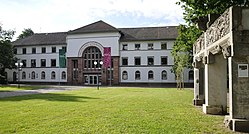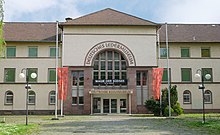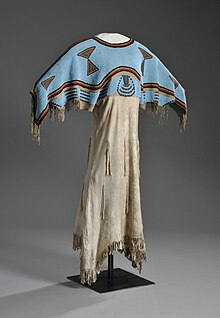German Leather Museum
 German Leather Museum, 2017 |
|
| Data | |
|---|---|
| place |
Offenbach am Main |
| Art |
Special museum
|
| architect | Hugo Eberhardt |
| opening | March 13, 1917 |
| operator |
DLM German Leather Museum
( public law institution ) |
| management |
Inez Florschütz
|
| Website | |
| ISIL | De-Of1 |
The German Leather Museum is a museum in Offenbach am Main . It was founded in 1917 by Hugo Eberhardt , originally as a collection of historical models for the training of young product designers , craftsmen and leather goods manufacturers. To date, more than 30,000 objects from all cultures and epochs have been brought together, which are divided into three areas of the collection - applied art , ethnology and the German Shoe Museum.
The building that houses the German Leather Museum is a cultural monument under the Hessian Monument Protection Act .
history
Hugo Eberhardt, the then director of the technical institutes (today: Hochschule für Gestaltung Offenbach am Main ), recognized during his work at the university that "... for the training of tomorrow's designers, the encounter with the historical object is essential". He began to build a collection of historical models for the training of young product designers, craftsmen and leather goods manufacturers. In view of the leather goods industry that was important for Offenbach at the time, this became the focus of the collection. Leather as a material should play the role of the medium and the door opener.
On March 13, 1917, Eberhardt opened the German Leather Museum on the occasion of the 25th anniversary of the reign of Grand Duke Ernst Ludwig of Hesse . This beginning was made possible by foundations of various leather goods factories in Offenbach as well as donations from Robert von Hirsch and others.
Eberhardt first showed the beginnings of the collection in the technical schools . From 1922, larger rooms in the Mainpfaltz villa on Kaiserstraße could be used. In 1938 the museum moved to its domicile on Frankfurter Strasse , which is still in use today .
In line with Eberhardt's intention to document leather production and processing both in time and in a global cultural comparison, more than 30,000 exhibits have been brought together to date.
After Eberhardt's death in 1959, his assistant Günter Gall took over the management of the museum for the next 30 years and expanded it twice, in 1960 and 1981. Renate Wente-Lukas was also followed by an employee in this post. From 2000 to 2014 Christian Rathke was director of the museum. During his tenure, the museum's ethnological departments in particular were expanded and the museum opened for educational work and representative use. Inez Florschütz, who has a PhD in history and art, has been the director of the museum since November 1, 2014.
building
Since 1938 the museum has been housed in the former warehouse of the Offenbacher Messe, which was built in 1829 in the classical style. The building became necessary because a customs agreement between the Grand Duchy of Hesse and the Kingdom of Prussia was concluded in 1828 , which the trade fair city of Frankfurt initially did not join. As a result, Offenbach organized its own trade fair from September 1828 with great success. In 1836 the city of Frankfurt joined the expanded German Customs Union , which led to the end of the Offenbach trade fair. The building was rebuilt in 1938 according to Eberhardt's plans and has since been used as a museum.
The external appearance of the part of the former warehouse is worth protecting as a cultural monument. It is a broad, originally two-storey structure facing the stone wall. The portal forms a central risalit with a high, former archway and partial sandstone cladding. The building has a high historical testimony value as a document of a time of the rapid economic boom and the rapid industrial development of Offenbach, which is why it is a cultural monument according to the Hessian Monument Protection Act . The facility is therefore a listed building .
Although the name of the designer (s) is unknown, this functional building can be counted among the structures influenced by the Darmstadt senior building officer Georg Moller .
Divisions
The German Leather Museum brings together three collections:
- Collection for applied arts
- Ethnological collection
- German Shoe Museum
Collection for applied arts
The collections for applied arts contain masterpieces of European leather design from the Middle Ages to the present day. From Egyptian-Coptic leather goods to handicrafts from various centuries to manufactured and industrial products of more recent times. There are exhibits such as belts, bags, ceremonial shields and weapons, armor, masks, leather book covers and minne boxes, briefcases by Napoleon Bonaparte and his wife Josefine and luggage, among others from the manufacturer Louis Vuitton . Another area of the collection is international bag and shoe design of the 20th and 21st centuries.
Ethnological collection
The ethnological collection offers a broad cross-continental exhibition. The highlights are the America, Africa and Asia departments, especially with the globally significant Oriental, Chinese and Southeast Asian shadow puppets, as well as remarkable holdings from Japan, China and Tibet.
The North America exhibition focuses on objects from the indigenous USA and Canada and focuses on ethnic groups such as the Diné , Hopi , Blackfoot or, for example, the Sioux. The exhibition shows how dependent individual indigenous groups lived on what the environment provided them and that the climate determined the material equipment. The exhibition on cowboys and cattle breeders from North and Central America is also significant.
The Asian exhibits are one of the world's most important collections of oriental, Chinese and Southeast Asian shadow puppets made of parchment . There are also figures from Egypt and Turkey.
The Africa exhibition focuses on cattle breeders from the savannah and the Sahel region of West Africa, as well as the cattle and camel nomands in the Sahara desert and the steppes of East Africa.
There are also exhibits from Japan, including important collection items on the samurai, China, Tibet and the polar regions.
German Shoe Museum
A special collection of its own is the German Shoe Museum with over 15,000 exhibits, which brings together international footwear from four millennia. These include boots from Roman legionaries and platform shoes from Venetian courtesans, as well as elegant silk boots from Empress Sisi and Joschka Fischer's sneakers , which he wore when he took office as Hessian Minister of the Environment. The numerous silk shoes of the nobility from the 18th century form a special focus. There are also exhibits from Egyptian mummy tombs, Iran, Italy, China and many other countries.
Others
- The leather museum has been advertised since July 2017 with the help of information boards on federal motorway 3 .
- In the German Leather Museum there has been an expanded cinema hall since 1980, which is named after the founder of the museum: Hugo-Eberhardt-Saal. Regularly changing events take place here. Was important cinema in leather palace , which from 2011 to 2017 in collaboration with the Association cinema in the DLM was organized. The collaboration ended because the film series no longer fit into the content and business management concept of Inez Florschütz, head of the Leather Museum.
- The museum's collections are barrier-free with ramps and lifts.
- The final resting place of Hugo Eberhardt , the former director of the German Leather Museum, is also here. His urn is kept behind a grave wall.
- Probably the world's largest tusk of a narwhal with a length of 2.74 meters is in the German Leather Museum.
- The portal of Lederwerke J. Mayer & Sohn is located in the open space in front of the museum . After a partial reconstruction, it was erected there in 2013 as a memorial to a piece of Offenbach's industrial history . The administration building, which was formerly adorned by the portal, was designed by Hugo Eberhardt.
- The museum regularly takes part in the Frankfurt & Offenbach Museum Night .
- The German Leather Museum is part of the Route der Industriekultur Rhein-Main project .
- The museum took part in the Leather to Light project ! at the eighth Luminale in March 2016. The interactive installation was developed in cooperation with the Hochschule für Gestaltung .
Exhibitions (selection)
- 2010: Marrakech - Between modernity and 1001 nights
- 2011: shadow play figures
- 2012: Just a touch ... Subjects: a special communication tool
- 2012/2013: Race against impermanence
- 2013: Cultures on the edge of the Chinese world: Mongolia, South Siberia, Korea
- 2014: Roger Vivier - Footwear
- 2015: bags! Tradition and quality - recycling and upcycling - refinement
- 2016: Leather - a companion through life
- 2017: Linking Leather - The diversity of leather
- 2017: Leather.World.History. 100 years of the German Leather Museum
- 2018: In focus: bags - functional, decorative, fashionable
- 2018: this is leather! From A to Z
literature
- Günter Gall, Renate Wente-Lukas: German Leather Museum, German Shoe Museum Offenbach. Westermann, Braunschweig 1981, DNB 810983036
- Wolfgang Jäger: From craft to industry, origin and development of the leather trade in Offenbach am Main - Festschrift for the 75th anniversary of the German Leather Museum with the affiliated German Shoe Museum. German Leather Museum / German Shoe Museum, Offenbach 1992, ISBN 3-87280-075-2
- Jutta Göpfrich, Nina Frankenhauser and Katharina Mackert: a race against transience. A Race Against Transience. Exhibition catalog. Berthold, Offenbach 2012, ISBN 978-3-9815440-0-8
- Rosita Nenno: Footwear, Roger Vivier . Berthold, Offenbach 2014, ISBN 978-3-9815440-2-2
- Andreas Hansert : Offenbach am Main. Culture in the wake of National Socialism. Applied Arts School, German Leather Museum, Klingspor font foundry. Böhlau Verlag , Vienna 2019, ISBN 978-3-2052089-6-9
Web links
- Literature from and about the German Leather Museum in the catalog of the German National Library
- Website of the German Leather Museum
- Lisa Berins, Matthias Dahmer: It is always only patched - the German Leather Museum is struggling with massive financial problems. In: op-online.de. February 16, 2018, accessed February 16, 2018 . Interview with manager Inez Florschütz
Individual evidence
- ^ Günter Gall : Obituary - Hugo Eberhardt . In: Art Chronicle . No. 11 . Munich November 1959, p. 294 f .
- ↑ Wolfgang Jäger: From craft to industry: origin and development of the leather trade in Offenbach am Main, commemorative publication for the 75th anniversary of the German leather museum with the affiliated German shoe museum, on March 13, 1992. ISBN 978-3-87280-075-6 , P. 7.
- ↑ March 13, 2007 - 90 years ago: German Leather Museum founded in Offenbach. In: wdr.de . March 13, 2007, accessed April 7, 2016 .
- ^ Hugo Eberhardt : A German Leather Museum in Offenbach a. Main . In: German art and decoration . No. 7 -8 (April / May). Alexander Koch Publishing House , 1917, ISSN 2195-6294 , p. 186–196 , here p. 196. ( digi.ub.uni-heidelberg.de [accessed on April 7, 2016]).
- ↑ Lothar R. Braun: Leather Museum looks ahead to 100 years of existence. In: op-online.de. April 21, 2015, accessed April 7, 2016 .
- ↑ Former museum director Günter Gall is dead. In: fr-online.de . December 16, 2008, accessed February 4, 2015 .
- ↑ Lothar Braun: 1917: About the "Schnorrer" and his Minneebox . ( Memento from January 19, 2014 in the Internet Archive ). Originally in: Offenbach-Post , December 10, 2008, most recently online at offenbach.de .
- ↑ Markus Terharn: Dr. Christian Rathke leaves. Leave the house well ordered. In: op-online.de. August 23, 2014, accessed July 3, 2015 .
- ↑ Turning point in the museum. In: fr-online.de. June 25, 2014, accessed October 15, 2014 .
- ^ New boss for the German Leather Museum in Offenbach. In: fnp.de . October 2, 2014, accessed October 15, 2014 .
- ↑ State Office for the Preservation of Monuments Hesse (ed.): Frankfurter Straße 86 In: DenkXweb, online edition of cultural monuments in Hesse .
- ↑ 23 - German Leather Museum. ( Memento from March 24, 2016 in the Internet Archive ) On: offenbach.de , accessed on March 18, 2016.
- ↑ a b For the entire section: Collections. From: ledermuseum.de , accessed on August 8, 2017.
- ↑ German Leather Museum, German Shoe Museum. Catalog issue 6. Würzburg 1980.
- ↑ Cinema in the Lederpalast - Leather Museum. Retrieved August 16, 2017 .
- ^ Claus Wolfschlag: Municipal cinema in Offenbach always failed due to the lack of visitors. Now there is a new attempt. In: op-online.de. September 9, 2011, accessed July 3, 2015 .
- ↑ Thomas Kirstein: After a forced departure from the Leather Museum, the cooperation “Kino Kulinarisch” saves the future at EVO. In: op-online.de. December 21, 2017, accessed January 16, 2018 .
- ↑ DLM - opening times. ( Memento from March 4, 2016 in the Internet Archive ) On: ledermuseum.de , accessed on March 11, 2016.
- ↑ Reinhold Gries: The forgotten day of death. op-online.de, August 27, 2009, accessed on July 3, 2015 .
- ↑ Guinness Book of Records 1992, Ullstein, ISBN 3-550-07750-5 .
- ↑ Jörg Echtler: Monument for the Mayer works. In: fr-online.de. October 16, 2013, accessed July 9, 2015 .
- ^ Anton Jakob Weinberger: Goat skins and heroic workers. In: faz.net. October 27, 2013, accessed July 9, 2015 .
- ^ Claus Wolfschlag: Night of the museums in Offenbach. In: op-online.de. May 6, 2013, accessed July 3, 2015 .
- ↑ Markus Terharn: Night of the Museums attracts four institutions in Offenbach. In: op-online.de. April 22, 2015, accessed July 3, 2015 .
- ↑ Local route guide No. 9 of the Route der Industriekultur Rhein-Main. (PDF; 519 kB) In: krfrm.de. KulturRegion FrankfurtRheinMain gGmbH, December 2005, accessed on November 14, 2015 .
- ↑ Luminale in Offenbach: Illuminated in two senses. In: op-online.de. February 26, 2016, accessed March 12, 2016 .
- ^ Jan Schuba: Leather Museum participates in the Luminale for the first time. In: op-online.de. March 15, 2016, accessed March 15, 2016 .
- ↑ http://www.ledermuseum.de/archiv/
- ↑ Sigrid Aldehoff: Between tradition and modernity. In: fr-online.de. January 15, 2010, accessed April 22, 2015 .
- ↑ On the canvas scenes from shadows in: FAZ of August 13, 2011, page 59.
- ↑ Monica Bielesch: exhibition at the Leather Museum: Tools of coquetry. In: fr-online.de. April 14, 2012, accessed October 16, 2014 .
- ↑ http://www.ledermuseum.de/archiv/
- ↑ Offenbach am Main, DLM - German Leather Museum / German Shoe Museum. (PDF; 7.7 MB) In: The Art History of East Asia. Center for East Asian Studies, November 2013, p. 184 f. , accessed July 8, 2015 .
- ^ Exhibition: Roger Vivier - Footwear in the German Leather Museum Offenbach. In: vogue.de. March 21, 2014, accessed October 16, 2014 .
- ↑ Silvia Bielert: Luxurious, functional, sustainable. In: fr-online.de. December 17, 2014, accessed February 4, 2015 .
- ↑ Lisa Berins: Special exhibition "Leather - Companions Through Life" in the Offenbach Leather Museum. In: op-online.de. July 1, 2016, accessed July 1, 2016 .
- ↑ Linking Leather - The variety of leather. In: hfg-offenbach.de. Retrieved February 28, 2018.
- ↑ Antonia Faltermaier: Under the skin. In: ad-Magazin.de . September 21, 2017. Retrieved February 28, 2019 .
- ↑ Lisa Berins: German Leather Museum in Offenbach is dedicated to the bag as a cult object. In: op-online.de. June 22, 2018, accessed February 28, 2019 .
- ↑ Current - Leather Museum. Retrieved February 27, 2019 .








